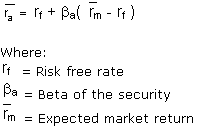Cost of retained earnings (ks) is the return stockholders require on the company's common stock.
There are three methods one can use to derive the cost of retained earnings:
a) Capital-asset-pricing-model (CAPM) approach
b) Bond-yield-plus-premium approach
c) Discounted cash flow approach
CAPM Approach
To calculate the cost of capital using the CAPM approach, you must first estimate the risk-free rate (rf), which is typically the U.S. Treasury bond rate or the 30-day Treasury-bill rate as well as the expected rate of return on the market (rm).
The next step is to estimate the company's beta (bi), which is an estimate of the stock's risk. Inputting these assumptions into the CAPM equation, you can then calculate the cost of retained earnings.
Formula
Example:
For Newco, assume rf = 4%, rm = 15% and bi = 1.1. What is the cost of retained earnings for Newco using the CAPM approach?
Answer:
ks = rf + bi (rm - rf) = 4% + 1.1(15%-4%) = 16.1%
b) Bond-Yield-Plus-Premium Approach
To estimating the cost of retained earnings. Simply take the interest rate of the firm's long-term debt and add a risk premium (typically three to five percentage points):
Formula
ks = long-term bond yield + risk premium
Example: bond-yield-plus-premium approach
The interest rate on Newco's long-term debt is 7% and our risk premium is 4%. What is the cost of retained earnings for Newco using the bond-yield-plus-premium approach?
Answer: ks = 7% + 4% = 11%
c) Discounted Cash Flow Approach
Also known as the "dividend yield plus growth approach". Using the dividend-growth model, you can rearrange the terms as follows to determine ks.
Formula
ks = D1 + g;
P0
where:
D1 = next year's dividend
g = firm's constant growth rate
P0 = price
You must also estimate g, which can be calculated as follows:
Formula
|
g = (retention rate)(ROE) = (1-payout rate)(ROE)
Example: discounted cash flow approach
Assume Newco's stock is selling for $40; its expected return on equity (ROE) is 10%, next year's dividend is $2 and the company expects to pay out 30% of its earnings. What is the cost of retained earnings for Newco using the discounted cash flow approach?
Answer: g must first be calculated: g = (1-0.3)(0.10) = 7.0%
ks = 2/40 + 0.07 = 0.12 or 12% |







0 comments:
Post a Comment